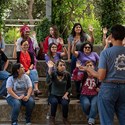Resources and Weekly Workshops
Welcome to The Writing Center resource hub!
Weekly Workshops are now being offered in RLC-205.
Join us for our new weekly writing workshops designed to help you excel in your academic and professional writing! Hosted by the talented tutors from the Writing Center, these workshops will cover a variety of essential skills:
- Reading Skills: Enhance your ability to annotate texts, improve reading comprehension, and develop critical reading strategies.
- Writing Skills: Master thesis statement development, essay structure, research paper writing, effective argumentation, revising and editing techniques, and plagiarism avoidance.
- Study Skills: Learn time management, note-taking strategies, test preparation, and stress management.
- Writing Across the Disciplines: Gain insights into science and technical writing, social sciences writing, humanities writing, business writing, and creative writing.
- Career Writing: Perfect your resume and cover letter, craft compelling personal statements, write scholarship essays, and learn job application tips and professional networking email etiquette.
Workshop Schedule:
- Monday-Thursday: 9 AM, 11 AM, 1 PM, 3 PM, 5 PM
Can't join a workshop?The following handouts provide general guidelines to support various aspects of the writing process.
If there is a specific topic you would like us to cover, please reach out to Caroline Kuyumcuoglu, Academic Program coordinator (ckuyumcoglu@alamo.edu)
*Students, while we hope you find these handouts helpful, your instructor's guidelines and preferences should always be carefully followed and prioritized.
Writing Process & Essay Planning
- Understand the Assignment
- Audience and Purpose
- General Writing Process
- Thesis Statement
- Paragraphs
- MLA Format
Clarity & Style
Grammar & Punctuation
- Redundant Acronyms
- Apostrophes
- Comma Splices
- Sentence Fragments
- Homonyms (Misspelled and Misused Words)
- Irregular Verbs
- MLA Format
- Modifiers
- Parts of Speech
Reading Strategies
- Strategies 01: Mumble, Read, and Listen
- Strategies 02: Skimming and Key Words
- Strategies 03: Marginal Notes and Mapping
- Strategies 04: Inductive/Deductive Reading and Annotating a Text
- Strategies 05: Reading/Rereading and Rumination
- Strategies 06: Reflection Points and Talking Through a Text
- Strategies 07: Hearing or Visualizing a Text
- Strategies 08: Start at the End and Summarize
- Strategies 09: Reading on a Walk and Moving When You Read
- Strategies 10: Confidence & Focus
- Strategies 11: A Special Place, A Journal, and Reading Rewards
Reading Improvement
MLA 9th Edition - Formatting
****The following guidelines are based on the MLA Handbook Ninth Edition. Students are advised to adhere to their instructor's specific requirements.

Fig. 1: The top of the first page of an MLA formatted page.
- Page Margins
- Margins are one inch at the top and bottom and on both sides of the text.
- Running Head and Page Numbers
- Pages are numbered consecutively in the upper right-hand corner, half an inch from the top and flush with the right margin. Type your surname (last name), followed by a space, before the page number.
- Title
- One inch from the top of the first page and flush with the left margin
- Include your name, instructor’s name, course name and number, and date on separate double-spaced lines.
- Center the title of your essay using title capitalization.
- Text Formatting
- Double-space the entire essay, including the Works Cited page.
- Indent the first line of a paragraph half an inch from the left margin.
- Indent block quotations half an inch as well.
- Leave one space after a period or other concluding punctuation mark.
- Use a readable typeface, e.g. Times New Roman, and font size between 11 and 13 points throughout your essay.
- Works Cited Page (last page)
- Center the heading, Works Cited, an inch from the top of the page.
- List entries in alphabetical order.
- Begin each citation flush with the left margin. Subsequent lines should begin half an inch from the left margin (hanging indent).
- Double-space the entire Works Cited page including the heading and each entry.

Fig. 2: The top of the first page of a works-cited list.









